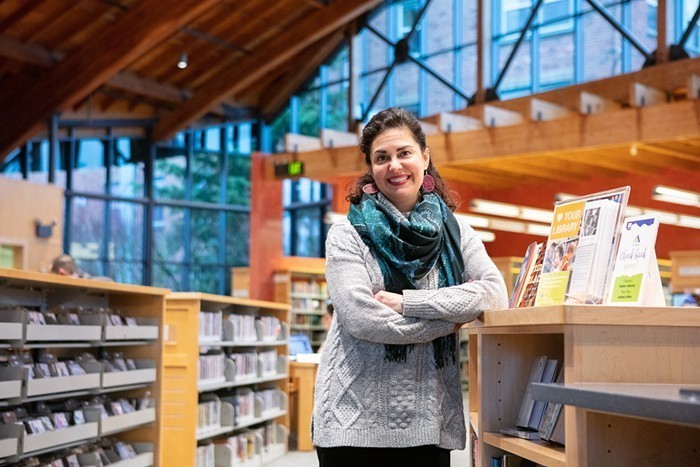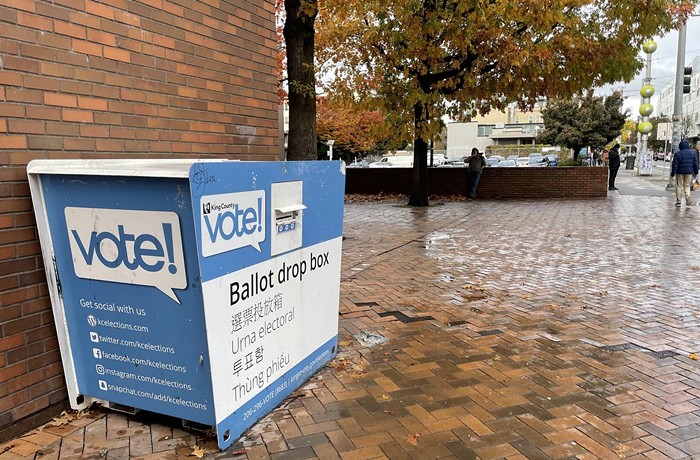"Streetcars are a huge development tool," says Dannen, a walking, talking streetcar encyclopedia. "You need a fixed route. People don't view buses as a permanent structure." Dannen is one of Portland's point people for the city's streetcar line, an impressive system that is Exhibit A in Nickels' plan to build a 2.6-mile trolley through South Lake Union, at a cost of $45 million. The mayor sees a South Lake Union streetcar as an important part of his package of proposed improvements to the neighborhood, which includes things like more housing, a big park on the southern tip of the lake, and a two-way Mercer Street. The overall plan could cost taxpayers up to $500 million.
The mayor's office--with help from Vulcan Inc., a landowner with a huge stake in redeveloping South Lake Union--has been hosting monthly trips to Portland to hear from Dannen's firm (Shiels Obletz Johnsen was hired to run the nonprofit Portland Streetcar Inc., which operates the streetcar) and tour the system. On April 30, about 50 people from Seattle--including Nickels, and Seattle City Council Members Heidi Wills and Richard McIver--headed south to check out the Rose City's streetcar.
That's why I'm here. Since Portland's system has been held up as the standard for Seattle, I wanted the tour that Nickels' office has been using to sell the streetcar to folks like members of the city council. I wanted to see if Nickels' comparison made sense.
Nickels' South Lake Union plans dovetail with ideas billionaire Paul Allen--and his company, Vulcan--has for the neighborhood, where he owns nearly 50 acres: Allen wants to see the area become a biotech hub. Allen and Vulcan have been working hard to woo biotech to South Lake Union. Under their plan, companies like ZymoGenetics, Amgen, and the nonprofit Seattle Biomedical Research Institute, plus Fred Hutchinson Cancer Research Center and the University of Washington, would intermingle in the neighborhood, creating a dynamic pool of scientific research and innovation. The plan would also bring up to 20,000 jobs to Seattle, proponents argue (The Stranger has questioned the number because it's based on the neighborhood's physical capacity rather than the number of employees companies are actually projecting ["Playing the Numbers," Amy Jenniges, May 22]).
The South Lake Union plans haven't escaped controversy. Current residents have been vocal, raising concerns about the proposals, worried that the changes will trample on the area's neighborhood plan. There have already been plenty of clashes between residents and the Vulcan/mayor's office team: protests over Vulcan's city-approved demolition of the low-income Lillian Apartments last fall, the alleged Vulcan attempts to stack the Cascade Neighborhood Council with pro-Vulcan folks, and residents' press conferences in the neighborhood denouncing the mayor's plans. "[The mayor's] grand plans are completely at odds with the neighborhood's goals," neighborhood activist John Fox said at a May 1 press conference.
On June 9 the city council signed off on a resolution supporting the plans to encourage biotech in South Lake Union, though they didn't say anything about a streetcar. Since then, a handful of property owners in the neighborhood (Allen ally bigwigs like folks from Fred Hutch, Pemco, Howard S. Wright Construction, and Vulcan itself) have lobbied for the streetcar in a letter to the city council. But folks who run smaller businesses along the proposed line aren't as thrilled with the streetcar idea, calling it a waste of money, and something they don't want to pay for--which they'd partly have to do, through a self-imposed tax. A lot of those folks are laying low, however, because they lease space from Vulcan and are timid about speaking up ["Vulcan Mind Meld," Amy Jenniges, June 19].
In the next several months, the city council will tackle the streetcar issue. One of the council's first decisions is whether or not to accept $3 million that State Representative Ed Murray (D-43) set aside from the state budget to fund streetcar planning--an allocation that upset a few council members, since it wasn't in their list of funding priorities. "We have huge, unmet transportation needs, like replacing Alaskan Way Viaduct and fixing the Mercer Mess, that should come first," council president Peter Steinbrueck wrote in a letter to the editors of the Seattle Times. Murray and Nickels fired back a few days later, pointing to Portland as the model for fixing Seattle's transportation problems. "To see what a streetcar can do for a city, look to Portland, where their new streetcar line has been an incredible success, helping spur development of the Pearl District," Murray said, channeling Nickels.
The streetcar has been a huge success in Portland. Dannen, at her office in a Chinatown-area historic brick building adjacent to Portland's rumbly MAX light-rail line, is more than happy to explain how it came together and what it's done for the city. I was curious to hear her out.
Dannen's desk alone is a wealth of information: Reports on how business owners along the streetcar line feel about the train, a breakdown of the costs to build it, a list of new development along the line, ridership numbers, maps, even brochures highlighting the restaurants within walking distance to the cars are all neatly sorted on her large U-shaped desk. "The city got serious about the streetcar in the late '90s," Dannen begins, launching into an overview of the two-year-old Portland system, while referencing her piles of streetcar paperwork.
Portland's system is impressive, and it's easy to understand why Nickels is using it as a shining example for his South Lake Union proposal: The line is a 4.8-mile roundtrip, circulating along a hooked path from Portland State University, north through downtown Portland and a newly refurbished neighborhood called the Pearl District, and then west to the city's densest neighborhood around Northwest 23rd Avenue, an area anchored by a large hospital. At Northwest 23rd, the train loops around and heads back the other way, toward the university. Along the way, the three-car trains pass everything from churches to art galleries, schools to office complexes. ("The only thing it doesn't pass is a funeral home," Dannen says.) The whole roundtrip takes about an hour, in trains that ride low to the ground--a design that makes riding it feel like you're floating on the street's surface. In the first year of operation, 1.35 million folks rode the train.
The city paid for the $56.9 million line, which opened in July 2001, through a local improvement district (LID) tax (property owners along the line agreed to tax themselves), funds from Portland's TriMet (that city's version of Metro), and a parking bond (a mix of increased parking fees and fines). Business owners along the line are thrilled at the new customers stepping off the train all day long, and into their shops, and they seem to have no problem paying the tax. "No one ever came to city hall to remonstrate against the [LID] tax," Dannen says.
But it's Dannen's final streetcar promo that's the most important to Nickels: "Over a billion dollars have been invested in redevelopment along the line," she points out, handing me a list of the projects built since the streetcar's planning stages in 1997. Within the entire local improvement district (an area covering two to four blocks outside the line) nearly 4,000 residential units have sprouted up, as has 2.25 million square feet of commercial space, for things like retail, offices, and hotels. One neighborhood along Portland's streetcar line is the poster child for this development boom. The Pearl District, just north of downtown Portland--sandwiched between the Willamette River and I-405--has been transformed from an industrial wasteland into a trendy urban neighborhood full of brick-and-glass condo and apartment buildings, with street-level retail and restaurants. There's more, Dannen says: "Property values have gone up at least 10 percent" along the route.
Nickels and Vulcan officials point to the Pearl District when describing the future of South Lake Union. With the addition of biotech, new residential units, street-level retail and restaurants, and, of course, a streetcar, South Lake Union will be a booming urban center. Artists' renditions of a new-and-improved South Lake Union resemble its Portland role model, with sidewalk cafes, refurbished storefronts, tree-lined streets, and shiny new buildings. The streetcar aspect of the South Lake Union-Pearl District analogy is key: If we build a streetcar like Portland's, officials argue, it's practically guaranteed that South Lake Union will enjoy a development surge like the Pearl District's.
But the analogy is flawed. First of all, the streetcar proposals themselves are radically different, in length and route. Secondly, the Pearl District didn't hinge its success on one industry, especially one with an uncertain future.
In Portland, the streetcar starts at one end of town, where a major university sits, and ends at another corner of the city, where there's a huge hospital. Along the way, it passes through downtown, and dense, previously established neighborhoods, along with the newly developed Pearl District (which straddles the midway point of the line, and pulls in people from both ends of long-established spots). The all-encompassing route--with plenty of destinations along the way where people want to go, like the art museum and Powell's City of Books--means more riders use the system. Seattle's proposal, on the other hand, doesn't tie together two major institutions, or link already bustling neighborhoods. It runs from the edge of downtown, circles a fairly desolate neighborhood, and heads back to the edge of downtown. There are very few people in South Lake Union right now to count on as riders (even Seattle's deputy mayor points out that ridership on the neighborhood's buses is low), and even fewer attractions along the route to draw people on board.
Portland's line is also much longer, at 4.8 miles roundtrip. One ride on the loop takes you through half the city. But Seattle's proposed line, in comparison, is a paltry 2.6 miles--a little over half the size of Portland's. Between the disparities in the route type and length, a truer analogy would require some imagination: If Portland had built a shorter loop from the edge of its downtown (near the world-famous Powell's bookstore) through the Pearl District, and nowhere else, it would resemble what Seattle is proposing. It's doubtful the Pearl District would have enjoyed so much development along a truncated line.
Secondly, the Pearl District was designed as a residential and cultural center, not a hotbed of industrial growth. It certainly wasn't designed with one business sector in mind. But Seattle wants to use the streetcar to attract biotech and biotech-related development, an industry that in itself is uncertain. Competition for the companies is fierce--city officials in 40 states want biotech hubs--and biotech isn't a proven investment. Moreover, Seattle has little in terms of capital to invest in the companies--something they desperately need to survive during the grueling, years-long process to develop new drugs or technology ["Bio Bust," Josh Feit, April 3]. As it is, relying on one sector is risky for South Lake Union, and there's no reason to assume that a streetcar will help the neighborhood's chances. In fact, if biotech busts or individual companies go under during the long R&D stage, South Lake Union might have a gorgeous streetcar, but no one to ride it.
For those reasons, and others, the Seattle City Council isn't quite ready to sign off on a streetcar. They may not even be interested in studying the proposal yet. Council president Peter Steinbrueck was quite vocal in his opposition to the $3 million streetcar-study appropriation from Rep. Murray, and also declined an invite from streetcar supporters to tour South Lake Union and hear the streetcar pitch. "I've lived here for 45 years. I know what South Lake Union looks like," he says. "I don't need to tour South Lake Union--that's not going to be persuasive." Likewise, Steinbrueck hasn't hitched a ride with the mayor's office to tour the Portland Streetcar (though he has checked out a similar system in San Diego). The streetcar, he says, seems like a "shortsighted approach to what's a bigger need" for transit in Seattle. Instead, he'd like to explore other, less costly options for downtown transit. "We ought to be looking at some sort of circulator system around downtown," he explains, linking together neighborhoods like Pioneer Square, the International District, Belltown, and South Lake Union. However, he might take a look at a South Lake Union streetcar if a majority of property owners agreed to a self-imposed tax that would cover half the cost of the line. "That would be persuasive," Steinbrueck says.
But the council member with the real clout in this issue is Richard Conlin, who chairs the transportation committee--where, rather than earmarking dough for a special South Lake Union streetcar, he's currently trying to plug the annual $15-$20 million shortfall facing the city's transportation-maintenance fund. Conlin hasn't taken a clear position on the streetcar, one way or another; instead he's taking a wait-and-see approach. His committee was supposed to take up the issue of whether or not to accept the $3 million in study funds in mid-July, but that date's been pushed back to the end of the month--streetcar planners are still hammering out plans for using the money.
In the meantime, with streetcar supporters now starting to throw themselves into the debate, Conlin would like to see more information, like ridership numbers and costs. "I'm ready to look at a proposal to see whether it's cost-effective," he explains. The $3 million from Murray would go toward that.
On the other side of the debate, a small army of streetcar supporters has emerged to support the streetcar plan. The "Build the Streetcar" committee, a group of prominent property owners and developers, along with key business owners in the neighborhood, signed a letter to the city council several weeks ago, urging the city to build a streetcar ASAP ["Vulcan Grip," Amy Jenniges, June 26].
"The streetcar is an important economic development and transportation solution that will connect four distinct Seattle neighborhoods--South Lake Union, Cascade, Denny Triangle, and downtown," the committee wrote in a statement for The Stranger. Listing the numerous new (and planned) developments in the neighborhood, like a QFC complex, the new federal courthouse, the relocation of architectural firm NBBJ and Cornish College of the Arts, and the city's new South Lake Union park--plus existing powerhouses like the Seattle Times, Fred Hutch, Pemco, REI, and others--the committee stressed the importance of a transportation system. "The streetcar will benefit the entire city and is as important to our downtown core and Denny Triangle as it is to the South Lake Union neighborhood. Revitalization does not occur without dedicated effort to create the infrastructure to support it. The time is now to invest and connect these neighborhoods."
Those supporters have allies at the city, too--like Ken Johnson, the man hired by the mayor's office to coordinate Nickels' South Lake Union agenda, including the streetcar. He hopes construction can begin a year from now. "It's a great circulator, so people don't have to rely on their cars" if they live in the South Lake Union neighborhood, he says. "Getting this close-in neighborhood developed, a really cool neighborhood, if you will, is the objective."
After seeing what the streetcar did for Portland, I understand Johnson's point. For what it's worth, I think Seattle should build a streetcar, one that will bring a mix of growth to South Lake Union. But the current proposal seems too shortsighted to achieve that goal. Here's my proposal: Emulating Portland's crosstown approach, the train would run from UW's main campus, through South Lake Union and downtown, to another major institution like Seattle Central Community College in the middle of Capitol Hill. The line would be a lot longer than a South Lake Union-only loop (and much more expensive), but with major anchors at both ends and developed areas in between, the riders would presumably be there. With a scenario like that, a streetcar just might pull investment into South Lake Union from both directions, à la the Pearl District.
Conlin is thinking along the same lines. "I want to make sure that when we're thinking about streetcars, we're not just looking at South Lake Union," Conlin says. He'd also like to look at extending the touristy waterfront streetcar, or eventually expanding the proposed South Lake Union line. "If we're going to do a system, let's do a system. This [proposal], right now, is just an idea."


















